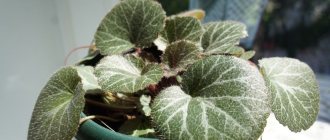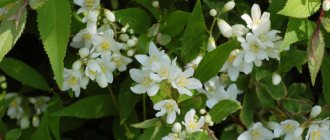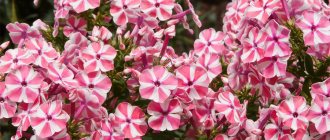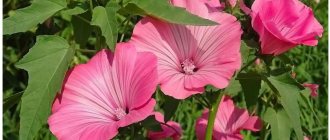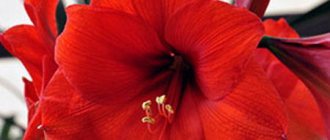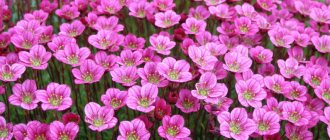Methods of propagation of saxifrage
Saxifraga can be propagated in several ways. Collecting and sowing seeds is only one of them. The material can be prepared independently after flowering.
A combination of saxifrage of different colors is effective - you can buy a mix of seeds or make your own
When planting and caring for perennial saxifrage, it can be propagated by rosettes, that is, by dividing the bush. This method is suitable for adult plants. Carry out the process when flowering is completed. Algorithm:
- Mark healthy bushes. They must have at least three sockets.
- Water the selected plants well.
- Carefully separate the additional sockets from the main one with a knife or a sharp garden spatula.
- Cover the cuttings of the mother plant with soil.
- Bury the separated rosettes in fertile soil. Choose a shaded place.
- Water.
- In spring, plant in open ground.
Comment! When propagated by division, saxifrage is more vulnerable. It takes longer to take root and spends more energy on it.
Before transplanting, rooting rosettes must be protected from the scorching sun. Regular watering and loosening is required.
After flowering, saxifrage can be propagated by cuttings. Algorithm:
- Select long side tendrils.
- Clamp them to the ground with staples.
- Cover the fixatives with soil.
- Water generously.
- Regularly moisten the soil so that the cuttings take root better.
- In the fall, mulch the ground, sprinkle the cuttings with leaves, sawdust or cover them with spruce branches.
- In the spring, separate the rooted shoots and replant them in a permanent place.
You can take cuttings and root them in a box. For the winter, it is better to place them in a cool room in the house. Saxifraga is transplanted in the spring.
Reproduction by cuttings or dividing the bush should be done not only for the sake of obtaining new plants. This also allows you to renew perennials that lose their decorative effect over time. The reason is excessive growth of stems and loss of leaves close to the ground.
Reproduction and planting
Before planting seedlings, lime, gravel, sand and high-moor peat should be added to the soil. Seedlings are planted in open ground using the transshipment method. Flower growers recommend not watering seedlings in cups 2-3 days before transshipment so that the earthen ball with seedlings can be easily removed. Seedlings are planted in moist soil.
Saxifraga seedlings are planted at a distance of no more than 20 cm, which will allow you to obtain a continuous and dense flower carpet. Seedlings are planted only on the shady side of the site. Water the seedlings in the morning and evening as the soil dries out. Loosening and weeding are carried out as necessary. The plants are fed once a month strictly with mineral fertilizers. Fertilizer is applied along with water during irrigation.
In the table we consider the main types of mineral fertilizers, as well as the timing and rates of their application.
| Fertilizers | Application period | Application rates g/m2 | Basic substances |
| Potassium | Autumn until spring planting. At the end of spring and summer | 15-20 | Potassium sulfate and carbonate |
| Phosphorus | 30-40 | Superphosphate Phosphorus flour | |
| Nitrogen | Spring, autumn | 30-40 | Ammonium sulfate |
| 25-30 | Ammonium nitrate |
The optimal temperature for saxifrage flowering is 20°C
Saxifraga is the most resistant plant to diseases and pests; it is practically not affected by pests and diseases. With improper care, in rare cases, plants are affected by diseases such as septoria. You can rid the plant of the disease with a weak solution of copper sulfate. As a preventative measure, regularly inspect the plantings and remove affected buds, as well as maintain moderate watering.
Pests include green aphids. The pest must be controlled using Bordeaux mixture. As a preventative measure, carry out regular inspection and remove affected leaves. In the table we consider the main reasons for the appearance of septoria and aphids on saxifrage plantings.
| Fertilizer name | Fertilizer application rate | Application period |
| Superphosphate | 5 g per well | When planting seedlings in open ground |
| Nitroammofoska | 5 g per 1 liter of water | 2 weeks after planting and at the budding stage |
| Azofoska | 5 g per 1 liter of water | During the period of active growth of green mass of flowers |
When planting and propagating Arends saxifrage, there are no special differences from other plants. You can grow flowers both on rocky, depleted soil and on fertile, well-fertilized soil.
We invite you to familiarize yourself with the renovation of the roof from slate to flexible tiles
Note! Excessive soil moisture leads to rotting of Arends' saxifrage.
It can grow both in the shade and in direct sun. The plant has no special whims, but the only thing that needs to be done regularly is watering.
In order for this amazing plant to bloom and delight its owners for a long time, it is necessary to follow certain rules when growing it from seeds.
Saxifraga White
Before sowing seeds, they need to be stratified. This is done for better germination. This procedure is performed in the following way:
- Mix the seeds with sand.
- Place the mixture in the refrigerator for two to three weeks.
Then you need to plant the seeds into seedlings. The next steps look like this:
- Prepare containers with a special mixture.
- Scald the soil with boiling water.
- Spread the seeds mixed with sand over the surface.
- There is no need to spray and cover the crops with film; there is no need to sprinkle with soil.
If all these steps are done correctly, then within 7-10 days the Arends saxifrage will produce its first shoots. Afterwards, stronger specimens with small leaves are dropped into peat pots.
To grow a plant in this way, various factors must be taken into account. However, the method is quite easy and fast. To get good bushes, it is recommended:
- Cut off rooted shoots or shoots with aerial roots.
- Transplant to a new place with a lump of earth.
Note! Arends saxifrage shoots do not tolerate cold.
Shoots that are longer than 5 cm are later cut and divided into several parts. The plant must be rooted in water or peat soil, but this must be done indoors.
Planting Arends saxifrage in open ground is very easy. You need to choose the right place for her.
- if this is an area with abundant sunlight, then it is important to regularly moisturize;
- in the case of partial shade, no special care is required.
Caring for saxifrage
It is customary to plant the plant in open ground in early June, when the seedlings are already sufficiently strong. After planting, Arends' saxifrage initially grows shoots, after which it blooms only after a year. The main thing is to choose the right soil, which will provide the plant with all the necessary nutrients.
Features of growing saxifrage from seeds
When growing saxifrage from seeds, several factors should be taken into account:
- The plant needs good drainage. This is important both when planting in open ground and when growing seedlings.
- The seeds are very small, so before sowing it is better to mix them with five parts of calcined river sand. This measure allows you to avoid excessive thickening of seedlings.
- Every 5-6 years, saxifrage needs to be replanted. This process can be combined well with updating the bushes.
Comment! Not all types of saxifrage can be grown as a cultivated plant. For guaranteed results, it is better to buy varietal seeds.
Saxifraga is popular in landscape design, as it blooms all summer and forms a beautiful continuous covering.
When can you sow saxifrage?
You can sow saxifrage in open ground or with seedlings in spring or autumn. When buying seeds in a store, you should focus on the recommendations for a specific type and variety.
Planting saxifrage in autumn
Saxifraga seeds can be planted in open ground in late autumn. This option is attractive because the material will undergo natural stratification. As a result, seedlings will emerge in spring, and the likelihood of flowering in the first year will increase.
Sowing saxifrage in spring
If you first grow seedlings, it is better to sow in early February. Move plants into open ground until July. In this case, they will have time to gain strength before the fall in order to successfully overwinter.
Reproduction and planting
Saxifraga, the planting and care of which is accessible to a gardener of any skill level, reproduces according to certain rules.
The usual vegetative method may not give results. The saxifrage plant reproduces through cuttings, seeds, layering and division of rosettes. All these methods are practiced either in early spring or in November. In this case, the seeds will germinate in the spring. Other methods should be planted in the fall, ensuring that the flowers have time to send out roots before frost and snow.
Germination of seeds
Most often, saxifrage for planting and care in open ground, as well as for indoor conditions, is sown indoors. In spring, the sprouts can be planted in the garden.
In the home version, the seeds are stratified by mixing them with sand and placing the container in the refrigerator for a period of a couple of weeks. The soil is slightly compacted, covered with the contents of the seed container and watered.
Then the container should be covered - the greenhouse effect stimulates seedlings. They will appear in 10 days; after they have 4 leaves, the sprouts are planted separately. They should receive moderate watering for the first few days.
Indoor seeding is more convenient and efficient
When planting in an outdoor garden, the next step is to prepare the soil. It should only be done when it is warm enough. For the future flower bed, apply a layer of soil suitable for saxifrage from 20 to 30 cm in thickness. The planted seedlings must be pre-watered again, and the soil is loosened at the planting points, where recesses are also made for the seedlings with an interval of 20 cm between them. After planting, these places are compacted a little; their first watering is carried out after about a week.
When sowing directly into the garden, the seed should be disinfected in potassium permanganate, strongly diluted with water, for a couple of days. Other fungicides will also work. The disinfected seeds are dried, sand is added to them, then the special soil already applied to ordinary soil is furrowed 1.5 cm. The seeds are planted, covered and watered.
Note! This is not the most effective method. If nothing has sprouted within a month after spring sowing, you can plant or sow other plants.
Rooting cuttings
The time for taking cuttings is late July. They should be from 7 to 15 cm long.
The shoot is cut below the node in flowers from two years old using a sharp blade. Its lower leaves are removed, and the cut is immersed in a diluted phytohormone for a few seconds.
The planting container is filled with wet sand. Before planting, treatment with charcoal powder is recommended. When the seedlings take root, they are planted separately or left in the sand until spring planting in the garden. In this case, tolerably cool temperatures and low lighting will be required.
Dividing bushes
This is the most common method. The sections of the plant that appear in the spring branching are separated in July, along with their roots, from the main bush by a sharp blade. The cuts are treated with wood ash, the rosette with fungicides, then the young saxifrage is planted in suitable soil. There should be at least 20 cm of free area around it. Planting in the garden should be done no earlier than spring. The first flowers can be expected next season.
Layerings
Picture 11 Layers serve to spread the cover of the bush
Note! The second most popular method of propagation is layering - this is the simplest method.
Under the new young shoots that have grown further away, in July small depressions are made in the ground, watered, after which the sprout is fixed there with a light handful of soil.
It should be watered on a standard schedule without overwatering in case of rainfall in garden conditions. The roots are produced in the fall, but the flower does not separate until spring. The cut is treated with wood ash, then the saxifrage from the layering is transplanted to its new place.
Planting saxifrage seeds for seedlings
Growing saxifrage from seeds is easy. It is necessary to properly prepare the soil, containers and planting material, and sow it correctly.
Preparing containers and soil
You can buy ready-made soil for seedlings or make a mixture yourself. The following components are taken in a ratio of 1:5:10:20:
- lime (can be replaced with chalk);
- vermiculite;
- sand;
- peat land.
For growing seedlings, you can choose different containers - plastic containers, small boxes, cups. It is important to organize drainage holes, since plants do not like stagnant moisture. The size of containers should be oriented towards a specific variety.
At first, seedlings can be grown in one box or large container, then picking will be required. Individual containers are filled with a mixture of peat and sand.
There is another option - to plant saxifrage seedlings in peat tablets.
Seed preparation
Saxifraga seeds require stratification before sowing for seedlings. After this treatment, seedlings appear faster, plants become stronger and more resilient. Algorithm:
- Place the seeds in a shallow container.
- Apply a thin layer of wet sand.
- Seal the container with a transparent lid.
- Place the container in the refrigerator for three weeks.
For convenience, seed stratification can be done directly in the seedling container. It needs to be filled with soil, and planting material should be spread on top in a thin layer. After stratification is completed, move the container to a bright place at a temperature of 18-20 °C.
How to sow saxifrage
After stratification, the seeds can be sown:
- Fill seedling containers with moist soil mixture.
- Spread the seeds on the surface.
- There is no need to cover the crops with soil.
Cover the container with the planted saxifrage seeds with film, glass or a transparent lid and place it on a light windowsill. The optimal temperature for germination is 18-20 °C.
Seed germination takes 1-3 weeks - the period depends on the variety and quality of the seed
No watering is needed until seedlings emerge. Daily ventilation and removal of condensate are required.
Saxifraga Arends at home
To grow a plant at home, you need to choose a small pot with low sides. Expanded clay is placed on the bottom as a drainage layer, and a clay-turf mixture is poured on top.
The flower pot should be placed in partial shade. The plant does not tolerate bright sunlight. The best place to place the pot will be the window sill located on the west or east side of the house.
The room temperature in spring and summer should not be higher than +24 degrees, in winter +12-14. If the temperature rises higher, the plant must be irrigated and watered frequently.
Feeding in winter is carried out once a month. The rest of the time, feed the plant every 15 days, alternating mineral fertilizers with organic fertilizers. It is not recommended to apply nitrogen-containing fertilizers.
During the flowering period, it is necessary to remove faded inflorescences and dry leaves. When the plant grows and there is no longer enough space in the pot, you need to transplant the flower into a pot larger than the previous one, but not by much.
Caring for saxifrage seedlings
When growing saxifrage from seeds at home, seedlings need some care. When shoots appear, the shelter must be removed. This is done gradually so that the flower gets used to fresh air. The rest of the events are:
- Water the seedlings with warm water. Focus on the condition of the soil, moisten it moderately.
- At the two-leaf stage, plant seedlings into individual containers.
- Shade plants from direct sunlight.
Comment! Planting saxifrage directly into peat tablets is labor-intensive due to the small size of the seeds. The advantage is that there is no need to pick seedlings.
3. Varieties of saxifrage:
3.1.Arends saxifrage - Saxifraga arendsii
Saxifraga Arends is a group of 40 species of evergreen perennial plants that do not exceed 20 cm in height. Plants of this variety form attractive rosettes of small, dark green leaves and form a dense herbaceous mat with age. The flowers are pink, pink, red or white, solitary, rising above the leaves on leafless stalks. Flowering is very abundant and occurs in May - June.
↑ Up,
3.2. Wafer saxifrage - Saxifraga stolonifera
An Asian ground cover, round-leaved plant, which is often grown at home as a hanging plant - in hanging pots. The plant has rounded dark green leaves, up to 10 cm in diameter, located on long petioles; branched veins are often highlighted in a lighter shade. The edges of the leaf blades have large denticles, the surface is covered with short pubescence. The plants form attractive stolons up to 90 cm long with miniature daughter rosettes that hang over the edges of the pots. During the flowering period, the plant forms tall leafless peduncles covered with fluff. At the top of the flower stalks are small interesting white flowers with 2 long and 3 short petals.
There are extremely beautiful variegated varieties with leaves colored burgundy, yellowish or pink.
↑ Up,
3.3.Saxifrage paniculata or tenacious - Saxifraga paniculata
An evergreen perennial plant that forms a leaf rosette of oblong-oval, thick, green or bluish leaves. The rosettes are attractive in themselves and resemble flowers. Miniature daughter rosettes appear on long stolons. The peduncles are very tall, often branched, bearing at the top many small pinkish, yellow or white flowers. The flowering period is very long - it can last throughout the summer.
↑ Up,
3.4. Soddy saxifrage - Saxifraga cespitosa
A plant with emerald green, palmately dissected, soft leaves reminiscent of deer antlers. The erect flower stalks bear several attractive yellow, white, pink or greenish flowers each. All parts of the plant have sparse, attractive pubescence. The height of the plants does not exceed 15 cm. In nature, this species lives on the island of Spitsbergen and, accordingly, tolerates extreme conditions.
↑ Up,
3.5. Shadow saxifrage - Saxifraga umbrosa
A perennial evergreen subspecies with fairly large leaf rosettes formed from dark green spoon-shaped leaves. During the flowering period, the plant produces very tall, thin peduncles with small pinkish flowers. Flowering is very abundant and long lasting - can last throughout the summer. Plants can reach a height of 35 cm.
↑ Up,
3.6. Mossy saxifrage - Saxifraga hypnoides
Miniature, slowly growing bushes, not exceeding 10 cm in height, grow with age and form a very dense mat. Leaf rosettes consist of light green or reddish burgundy, attractive, repeatedly dissected leaves. The flowers are located on small strong peduncles, with 5 oblong-oval, white, greenish or yellow petals.
↑ Up,
3.7.Reed saxifrage - Saxifraga lingulata or Saxifraga callosa
A perennial, herbaceous, evergreen plant with a dense leaf rosette up to 60 cm high. The plants develop slowly, but with age they are able to form a very dense mat. Leaf rosettes consist of long, belt-shaped leaves of a dark green color. The pubescent, erect flower stalks bear at the top several small white flowers, the petals of which often have purple dots on the surface.
↑ Up,
3.8. Saxifraga oppositifolia
A perennial herbaceous plant, the leaf rosettes of which do not exceed 5 cm in height. The leaves, as the name suggests, are arranged in opposite pairs on abundantly branching, creeping, strong shoots, sessile, green, about 6 mm long. Peduncles are low, strong, covered with sparse pubescence. The plant gains real attractiveness in June - July, when fairly large pinkish or lilac flowers open.
↑ Up,
How to plant saxifrage in the ground
You can plant saxifrage in the ground directly with seeds or seedlings. Each case has its own characteristics.
Deadlines
You can plant strengthened and mature seedlings in the ground in May or early June. The timing is based on the growth rate of the bushes and weather conditions.
Direct sowing of seeds into the ground can be done in April-May. The soil should warm up to 8-9 °C. This option is recommended in the southern regions. In cooler climates, it is better to start seedlings first.
Comment! When directly sowing saxifrage seeds into the ground, the first shoots will appear in 4-5 weeks. If you plant a plant in the spring, it will bloom in May-June or next year.
Site selection and preparation
Saxifraga is quite unpretentious, but still some factors are important for its good development and decorativeness. The site for the plant must meet the following requirements:
- the place is bright, but protected from direct sunlight at midday;
- no moisture stagnation;
- the soil is fertile, moderately moist and light.
Saxifraga can also grow in direct sun. If there is too much light, the leaves can become significantly lighter and there is a risk of burns, which can be expressed as dark spots. Insufficient lighting can slow growth and stop flowering.
Saxifraga feels good in a soil mixture of equal parts of sand, turf and humus. It is effective to add lime, peat, gravel. The selected area must be thoroughly loosened and removed from large roots.
Saxifraga feels good among stones and on sloping areas
Planting saxifrage seeds in open ground
When direct sowing in open ground, stratification is not necessary. Its seeds will pass naturally. The further algorithm of work is as follows:
- Prepare the area.
- Distribute the seeds over the loosened soil.
- Press the material tightly onto the soil or sprinkle it thinly with moistened sand.
After sowing the seeds, the bed can be covered with film. It will prevent moisture from evaporating quickly and will maintain the optimal temperature.
When the sprouts have three true leaves, you need to thin out the plantings, leaving the strongest specimens. Before this, abundant watering is recommended.
Many types of saxifrage grow well, forming a flower carpet - you can leave free space for this in advance
Landing algorithm
Transplanting saxifrage seedlings into open ground is not difficult. The algorithm is like this:
- Prepare the area.
- Water the seedlings generously a few days before transplanting.
- Carefully remove the bushes from the containers, keeping the earthen lump.
- Plant the plants at intervals of 10-20 cm.
Comment! It is necessary to move the seedlings to a permanent place in the evening. Transplantation during the day is possible on a cloudy rainy day.
The best ornamental varieties of saxifrage plants
Indoor saxifrage is perfect for beginning flower growers.
The undemanding nature of most species of this plant allows it to be placed in northern rooms and rooms with moderate access to sunlight. Bright lighting can make the plant look pale and cause disease.
This flower prefers dry and cool environments, it has massive leaves and generously produces tendrils. Saxifraga is a bush, the species of which like sparse watering, soil with plenty of sand, and look good next to petunias.
During the spring-autumn period, acceptable temperature values for saxifrage range from 20 to 25°C. In winter, the plant will suit 12-15°C, its subspecies with variegated leaves will need from 15 to 18°C.
Lighting
The flower can be planted near the shady sides of the window; the best option is the western and eastern sides of the house. Northern sides are also allowed, but when placed on the southern side, it will be necessary to provide the saxifrage with protection from direct rays of the sun.
Direct sunlight is not allowed
Fresh air stimulates its growth, which is why it is often placed on a summer balcony. Intense lighting is harmful, but lack of sunlight can also cause fading. In an open garden, the plant is planted in the shade.
Use settled water at room temperature. The soil should not be oversaturated with moisture, as this will lead to rotting of the roots. Drying out the soil is also unacceptable.
From the beginning of spring to the end of autumn, the house plant is watered no earlier than the top layer of soil has dried to a thickness of 2-3 cm, this is about 2 times a week. When located on open ground, precipitation should be taken into account.
For the winter period, the watering schedule is once every 8-12 days. Water should not accumulate in leaf rosettes; this can also contribute to rotting, and therefore the best method of watering is a tray. It should feed the pot only until the soil is completely moistened.
Spraying
The saxifrage should be sprayed with the same water as for watering. Infrequent spraying is carried out in spring and summer. If the air in the apartment is dry, it is carried out occasionally in winter.
Humidity
In winter, it is not recommended to keep the plant near radiators or heating devices, but to increase air humidity, you can dry wet things on adjacent radiators.
Despite its love for moisture, saxifrage thrives in dry climates, while frequent spraying can be harmful.
Additional Information. Humidity is increased by containing expanded clay, moss or pebbles in the tray; another way to humidify the room is to place vessels with water near the pot.
This flower is adapted to obtain useful substances from scarce mountainous areas and rocks, which is why ordinary soil is not suitable for it. Ideal for saxifrage would be a combination of garden or greenhouse soil, crushed gravel, lime, peat and sand.
All this is enough in the same quantity with the exception of gravel, a handful of which is enough for a volume of 5 liters.
Top dressing
Soil enrichment is carried out in summer, winter and spring with a fertilizer solution diluted in water.
In winter, fertilizing is done once every one and a half to two months, the rest of the time every two weeks.
Note! With a lack of nutrients, the sprouts spread chaotically, and the leaf bases lengthen. An excess increases the risk of fungal diseases.
In winter, the flower remains dormant.
The low activity of saxifrage in winter is explained by its adaptability to weather conditions.
Control of humidity, temperature and fertilizers, the conditions of which are common to most species, should be observed.
Those of them that can grow outside the house and are at the same time in an open garden do not need to be watered and fertilized in winter. Before the onset of cold weather and snowfalls, moderate mulching is necessary; the saxifrage is covered with grass.
These flowers are very diverse in shape, color and size, providing a wide choice for enthusiastic gardeners. For example, the shady saxifrage produces small, soft pink inflorescences, while the opposite-leaved flowers are deep pink and large, becoming purple over time.
Types of flowers
Saxifragas bloom in colors such as:
- white,
- red,
- lilac,
- purple,
- yellow,
- pink.
Additional information: certain varieties gradually change shade. There are also two-color and variegated flowers; the inflorescences of some species are painted with colored spots.
Among the saxifrage flowers, flowers of five short, oblong-rounded petals predominate.
There are also four-petalled ones, but this is a great rarity not inherent in any particular variety. Common standard forms on a smaller scale are bells and complex designs such as the wicker type.
Flowering begins in late spring and early summer; some weather-sensitive varieties may bloom in July.
The formation of inflorescences begins at the end of spring of the second year; they grow in the form of loose panicles. The first time there may be a small number of flowers.
Some varieties bloom in the fall, but generally the flowering time is from three weeks to the end of summer. After it, the flower stalks remain sticking out, so they are usually cut off.
At this time, saxifrage does not need any additional care beyond the usual spring-summer care. For more orderly flowering, panicles are sometimes trimmed.
Cultivated varieties of saxifrage can improve the appearance of any area. Ideal for growing in flower beds, in flowerpots, as well as for organizing organized flower beds and large stones. To grow saxifrage in the garden, choose varieties of soddy saxifrage Arends. The best varieties of Arends saxifrage include:
- Variety “Purpurmontel” - plant height does not exceed 20-25 cm. The flowers are medium bright, purple-pink in color, forming a very dense green carpet. Blooms in early June. The “Purpurmontel” variety is not afraid of frost; when grown as a perennial plant, it does not require shelter.
- Variety “Snow Carpet” - plant height does not exceed 15 cm. The flowers are medium bright, white, forming a dense green carpet. Blooms in mid-May. The “Snow Carpet” variety forms a dense cushion up to 3-5 cm in height. Ideal for decorating rocky areas.
- Variety "Flora Carpet" - plant height no more than 20 cm. The flowers are medium-sized, white-pink. Blooms beautifully on alpine hills. Blooms in early June. The "Flora Carpet" variety forms a dense cushion up to 3-5 cm in height. The only variety that prefers to grow on the sunny side of the site
- Variety “Flamingo” - plant height no more than 20 cm. The flowers are medium-sized, white-pink. Planted in small groups in garden plots and flower beds. Blooms in early June.
The Flamingo variety is most often grown as a perennial plant. Winter-hardy variety.
This rhizomatous plant, which can grow up to 70 cm high, is characterized by:
- creeping stems;
- branched root system;
- pronounced basal rosette;
- fleshy and leathery leaves.
Saxifraga Arends at home
The described plant has several subspecies, which differ mainly only in the color palette. All can boast of resistance to cold and ease of care. Among the most popular varieties are:
- Flamingo. According to the name, it has a soft pink bud color;
- White Carpet. Small inflorescences with snow-white bells bloom above the dark green shoots. Maximum diameter - 1 cm;
- saxifrage Purple carpet (Pink carpet, Purple Carpet). Probably the most beautiful and noble of those listed. Saxifraga purpurea has an aristocratic burgundy color with a yellow core;
- Floral Carpet is a very popular and beautiful plant, which is distinguished by its delicate white and pink shades.
Purple Carpet
Saxifraga Flower carpet covers the ground with graceful petals. Therefore, it is not surprising that all subspecies are very often used for exterior design, especially landscapes.
For your information! On the Internet you can find another name - Anders' saxifrage, but this is a mistake. In the botanical encyclopedia, the plant appears as Arends' saxifrage and has no other names.
Despite its praised unpretentiousness and simplicity, saxifrage still requires some attention for abundant flowering. Several recommendations on how to care for the vaunted plant.
We invite you to familiarize yourself with the Block diagram of the production of semi-finished meat products
Arends' saxifrage feels great both under aggressive sun and in partial shade. However, we must remember that keeping a plant in the shade for a long time can have a detrimental effect on its condition.
Important! It all depends on the air temperature. If it is above 20°C, it is advisable to provide the plant with a more shady place. Heat causes the rapid development of parasites and diseases, which has a very negative effect on the appearance of the plant.
Soil and fertilizers
Arendsa prefers light soils:
- loose build;
- low connectivity;
- easy workability.
Saxifraga in macro photography
One of the main factors when choosing soil is the presence of limestone, which has a very beneficial effect on the condition of the plant, fertility and good drainage.
Important! Superphosphate and bone meal are excellent fertilizers for saxifrage.
Although soil fertility is one of the main factors, you should not get carried away with fertilizers. The abundance of nutrients has an impact and is detrimental. Everything is good in moderation.
Watering and humidity
Saxifraga loves water very much. Watering should be done in moderation, since stagnant moisture destroys the roots of the plant. When planting, it is worth organizing in advance the drainage of excess water from the root system, ensuring drainage.
Regarding the temperature regime, saxifrage also has its own requirements. This noble plant does not survive at temperatures above 20°C. Surviving the winter is not a problem, but the heat can provoke many serious illnesses and the proliferation of pests.
Features of care
After moving seedlings into the ground or planting saxifrage with seeds, care should be comprehensive. In general, the plant is unpretentious.
Watering and fertilizing schedule
Saxifraga needs to be watered regularly, but in moderation. Moisturizing is required when the top layer of soil dries out. Watering should be done early in the morning or after sunset. The water should be warm and settled.
On cool days, plants need to be moistened less. In hot weather, the frequency of watering is increased.
Watering saxifrage during the day can cause burns to leaves and flowers.
It is recommended to feed saxifrage every month. The plant does not need fertilizers only in October-February. They should be applied for the first time three weeks after planting.
The flower responds well to mineral compositions. Dosages per 1 m²:
- 15-20 g potassium
- 30-40 g phosphorus;
- 30-40 g of ammonium sulfate, no need to add in summer;
- 25-30 g of ammonium nitrate, use only in spring and autumn.
If you use liquid concentrates, then you need to dilute them twice as much as according to the instructions. Fertilizing should be combined with watering.
Comment! Nitrogen fertilizers provide an abundance of green mass, but have a bad effect on flowering. If there is an excess of fertilizing, there is a risk of death of the root system and the spread of rot.
Loosening, mulching
The area with saxifrage needs to be weeded regularly. Loosening is recommended after each watering or heavy rainfall. The need for this procedure and moistening can be reduced by mulching. It is good to use straw for this. The material must be spread out in a 5-centimeter layer and updated regularly.
Care during the flowering period
During flowering, it is important not to forget about standard care measures - watering, weeding, loosening. To maintain decorativeness, you should regularly get rid of dried leaves and flower stalks.
Advice! To maintain the decorative appearance of saxifrage after flowering, it is recommended to trim its above-ground part. This stimulates the growth of new leaves.
Wintering
Preparing saxifrage for winter is not difficult. Main events:
- Stop watering and fertilizing.
- Trim off the above-ground parts.
Saxifraga is a frost-resistant plant, so it requires shelter only in cold regions. It is effective to use spruce branches or leaves for this (layer 10 cm).
Features of saxifrage: planting in open ground, care
Saxifraga can decorate any garden or summer cottage. At the same time, there are no special difficulties in growing and caring for it. It grows on rocky soils and will be a wonderful decoration for a rock garden or alpine slide. This plant has many varieties and almost all of them are decorative.
Features of saxifrage
This plant is perennial, but annual and biennial varieties are sometimes found. As you can see in the photo, the color of their flowers is varied: white, yellow, pink. The leaves can be dense, leathery, round or oblong.
In its natural environment, saxifrage grows in gorges and rocks . In landscape design, it is used as a ground cover plant and decorates borders. Due to the large number of plant varieties, they were divided into several groups. But three of them are mainly used in culture:
- Silver;
- Violet;
- Mossy.
Plants of the purple group are formed in the form of a cushion of leafy rosettes. They are very resistant to cold and other vagaries of weather, like specimens of the mossy variety. The group includes mainly short dwarf species . Saxifragas from the silver group usually have gray leaves with white speckles and yellow flowers.
Open ground: planting
In the garden, it is good to provide saxifrage with rocky soil. It is important that it is permeable, allowing air and moisture to pass through. When grown in a rock garden, stones will protect the roots of the plant from the sun and retain moisture.
But the plant will easily take root in ordinary soil. The main thing is to provide it with a good drainage layer to avoid moisture stagnation. It would be a good idea to add some crushed limestone and compost to the soil before planting . You can also prepare a special mixture. For this you will need:
- Leaf humus;
- Turf land;
- Peat;
- Sand.
Expanded clay or gravel is suitable for the drainage layer.
For some species of saxifrage, rock gardens are made from tuff, a special calcareous stone. This is a soft porous material that absorbs moisture like a sponge and retains it. Due to this, the plant requires watering less often.
All necessary procedures for caring for saxifrage are quite simple. It is necessary to loosen the soil and remove weeds. You can mulch the soil to prevent their growth.
Despite the plant's resistance to cold, it is recommended to insulate it for the winter . Foliage and spruce branches are suitable here. When it comes to lighting, diffused light is the best option for many species. Some varieties can also be planted in shaded areas. But in the open sun they can get leaf burns. In this sense, Arends saxifrage is unpretentious.
It is advisable to water saxifrage in moderation, slightly increasing moisture during the growth period. But the soil must dry out between waterings. Spraying will be useful, especially in dry weather.
Mineral complex compositions are suitable for fertilizing saxifrage . They are applied for the first time a week after the seedlings are moved into open ground. And then feeding 2 times a month in spring and summer is enough. Fertilizers can be applied in liquid form along with watering.
You should be careful when feeding saxifrage. Excess nitrogen fertilizer can lead to root dieback or rot infection. It is optimal to add a thin nutrient layer to the hole when planting. Superphosphate and a little organic compound are used.
Transplantation and illness
After flowering, it is better to cut off the above-ground part of the saxifrage. This measure is necessary for the development of new leaves. Transplantation is an integral part of care; it rejuvenates the plant . In addition, dividing bushes can be combined with the procedure. But you shouldn't do it too often. Saxifraga grows in one place for about 5-7 years.
Among the pests that can annoy the plant are spider mites and green aphids . Prevention of ticks is a simple spraying with water. But if the pest has already appeared, then it is better to use special means. Before this, it is recommended to remove all affected and wilted parts of the saxifrage. They fight green aphids with “Pyrimor”.
The most common diseases:
- Fungal infections and rust usually appear from improper watering regimes. Treatment of the plant with copper-based preparations will help;
- Powdery mildew is also caused by excess moisture. For prevention, spraying with drugs such as propiconazole and bitertanol is suitable.
Also, due to stagnation of moisture in the soil, the roots of the plant can rot. In this case, it is necessary to dig up the bush and separate all the diseased parts of the plant, destroying them, and the healthy ones must be planted in nutritious soil so that they take root.
Type of saxifrage "Arendsa": subtleties of care
One of the common species that gardeners grow is Arendsa. It can often be found in rock gardens. The plants are quite low, they can reach 20 cm in height . Their leaves are a rich green color that stays that way all year round. Blooms in May-June. Many popular varieties have been bred based on this species:
- “Sleeping Beauty” variety has deep red buds;
- "Peter Pan" with bright red flowers;
- 'Floral Carpet' has pink and purple flowers;
- “Snow Carpet” this variety pleases with the snow-white color of its flowers. Another white-flowered variety is “Schneeteppich” with dark green leaves;
- 'Purpurmantelle' has purple-pink flowers.
In addition to the Arendsa saxifrage, other varieties can be seen in the photo.
Diseases and pests
Saxifraga has good immunity, but this does not provide an absolute guarantee of the absence of diseases and pests. Often they are caused by improper plant care or unfavorable climatic conditions.
One of the problems is powdery mildew. This is a fungal disease provoked by high humidity, excess nitrogen, and strong thickening of plantings. It is expressed by a white coating of mycelium on the leaves. When the spores mature, droplets of liquid appear. The affected parts of the plant turn brown and fall off.
There are several methods to combat saxifrage powdery mildew:
- fungicide preparations – Topaz, Fundazol, Fitosporin, Alirin-B, colloidal sulfur, copper sulfate;
- folk remedies - whey, iodine, potassium permanganate, onion peel infusion.
To prevent powdery mildew, it is necessary to destroy the affected residues and use potassium-phosphorus fertilizers
Another fungal disease is rust. It appears as pads on the leaves, from which orange powder spills out after cracking. These are fungal spores.
Leaves affected by rust dry out and fall off, and the plant’s immunity decreases. You need to fight the disease with fungicides: Topaz, Fitosporin-M, Baktofit, colloidal sulfur, Bordeaux mixture.
To prevent rust, you need to burn plant residues, water the saxifrage moderately, and do not overfeed it with nitrogen.
Rust affects all above-ground parts of the plant and can destroy it.
With excessive watering and poor drainage, saxifrage can suffer from root rot. At the same time, the above-ground parts of the plant wither, the flowers fall off, and the entire bush gradually dies. For treatment, fungicides are used - Alirin-B, Diskor, Glyokladin.
Root rot is transmitted through soil and various equipment - sterilization is necessary for prevention
Among the pests, saxifrage can be affected by the mealybug. The size of the insect is only 5-10 mm.
The mealybug attacks the above-ground parts of the plant. The sign is a white cotton wool-like waxy coating. You can remove it with a cotton swab dipped in soapy water. Then spraying is needed:
- drugs – Aktara, Fitoverm, Biotlin, Tanrek;
- folk remedies - infusion of garlic or tobacco, decoction of cyclamen.
To prevent mealybugs, it is necessary to promptly remove dried leaves.
Saxifraga can be affected by aphids that feed on plant juices. At the same time, the flower begins to dry and wither and slowly dies. There are many ways to combat the pest:
- drugs – Tornado, Tanrek, Biotlin, Aktara, Apache;
- sticky traps;
- folk remedies - solutions of garlic, onion, tobacco, chamomile, potato tops
- plants that repel aphids with a strong smell - garlic, fennel, mint, coriander, basil, marigolds.
The color of aphids depends on its type and can be black, red, green, brown, yellow
Another enemy of saxifrage is the spider mite. It is difficult to see, but can be identified by a thin cobweb on the undersides of the leaves, white dots, and causeless drying. To combat ticks, the drugs Fufanon, Kleschevit, Fitoverm, Bitoxibacillin, and Iskra Bio are used.
The size of a spider mite is less than 1 mm; the pest is not dangerous for people, animals and birds

